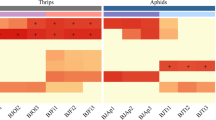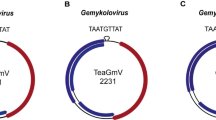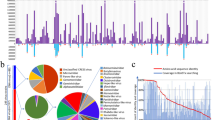Abstract
Studies on plant viruses are biased towards crop diseases and little is known about viruses in natural vegetation. We conducted extensive surveys of plant viruses in wild Brassicaceae plants occurring in three local plant communities in central Japan. We applied RNA-Seq with selective depletion of rRNA, which allowed us to detect infections of all genome-reported viruses simultaneously. Infections of Turnip mosaic virus (TuMV), Cucumber mosaic virus (CMV), Brassica yellows virus, Pelargonium zonate spot virus, and Arabidopsis halleri partitivirus 1 were detected from the two perennial species, Arabidopsis halleri subsp. gemmifera and Rorippa indica. De novo assembly further detected partial sequences of a putative novel virus in Arabis fragellosa. Virus species composition and infection rate differed depending on site and plant species. Viruses were most frequently detected from the perennial clonal plant, A. halleri, in which a high clonal transmission rate of viruses across multiple years was confirmed. Phylogenetic analysis of TuMV and CMV showed that virus strains from wild Brassicaceae were included as a major clade of these viruses with other reported strains from crop plants, suggesting that viruses were shared among wild plants and crops. Our studies indicated that distribution of viruses in natural plant populations are determined by the combinations of life histories of viruses and hosts. Revealing viral distribution in the natural plant communities improves our knowledge on the ecology of plant viruses.


Similar content being viewed by others
References
Tomlinson JA, Carter AL, Dale WT, Simpson CJ (1970) Weed plants as sources of cucumber mosaic virus. Ann Appl Biol 66:11–16. https://doi.org/10.1111/j.1744-7348.1970.tb04597.x
Mueller EE, Groves RL, Gratton C (2011) Crop and non-crop plants as potential reservoir hosts of alfalfa mosaic virus and cucumber mosaic virus for spread to commercial snap bean. Plant Dis 96:506–514. https://doi.org/10.1094/PDIS-02-11-0089
Roossinck MJ (2012) Plant virus metagenomics: biodiversity and ecology. Annu Rev Genet 46:359–369. https://doi.org/10.1146/annurev-genet-110711-155600
Aranda MA, Freitas-Astúa J (2017) Ecology and diversity of plant viruses, and epidemiology of plant virus-induced diseases. Ann Appl Biol 171:1–4. https://doi.org/10.1111/aab.12361
Islam W, Zhang J, Adnan M, Noman A, Zainab M, Jian W (2017) Plant virus ecology: a glimpse of recent accomplishments. Appl Ecol Environ Res 15:691–705. https://doi.org/10.15666/aeer/1501_691705
May RM, Anderson RM (1983) Epidemiology and genetics in the coevolution of parasites and hosts. Proc R Soc Lond B Biol Sci 219:281–313. https://doi.org/10.1098/rspb.1983.0075
Prendeville HR, Ye X, Morris TJ, Pilson D (2012) Virus infections in wild plant populations are both frequent and often unapparent. Am J Bot 99:1033–1042. https://doi.org/10.3732/ajb.1100509
Li L, Liu J, Zhang Q, Fu R, Zhu X, Li C, Chen J (2016) Seed-borne viral dsRNA elements in three cultivated Raphanus and Brassica plants suggest three cryptoviruses. Can J Microbiol 62:287–295. https://doi.org/10.1139/cjm-2015-0788
Alexander HM, Bruns E, Schebor H, Malmstrom CM (2017) Crop-associated virus infection in a native perennial grass: reduction in plant fitness and dynamic patterns of virus detection. J Ecol 105:1021–1031. https://doi.org/10.1111/1365-2745.12723
Pagán I, Montes N, Milgroom MG, García-Arenal F (2014) Vertical transmission selects for reduced virulence in a plant virus and for increased resistance in the host. PLoS Pathog 10:e1004293. https://doi.org/10.1371/journal.ppat.1004293
Bottenberg H, Irwin ME (1992) Using mixed cropping to limit seed mottling induced by soybean mosaic virus. Plant Dis 76:304–306. https://doi.org/10.1094/PD-76-0304
Jones RAC, Ferris DG (2000) Suppressing spread of alfalfa mosaic virus in grazed legume pasture swards using insecticides and admixture with grass, and effects of insecticides on numbers of aphids and three other pasture pests. Ann Appl Biol 137:259–271. https://doi.org/10.1111/j.1744-7348.2000.tb00067.x
Hooks CRR, Fereres A (2006) Protecting crops from non-persistently aphid-transmitted viruses: a review on the use of barrier plants as a management tool. Virus Res 120:1–16. https://doi.org/10.1016/j.virusres.2006.02.006
Pedersen AB, Fenton A (2007) Emphasizing the ecology in parasite community ecology. Trends Ecol Evol 22:133–139. https://doi.org/10.1016/j.tree.2006.11.005
Callaway RM (1995) Positive interactions among plants. Bot Rev 61:306–349. https://doi.org/10.1007/BF02912621
Seabloom EW, Borer ET, Gross K, Kendig AE, Lacroix C, Mitchell CE, Mordecai EA, Power AG (2015) The community ecology of pathogens: coinfection, coexistence and community composition. Ecol Lett 18:401–415. https://doi.org/10.1111/ele.12418
Filipe J, Maule M (2004) Effects of dispersal mechanisms on spatio-temporal development of epidemics. J Theor Biol 226:125–141. https://doi.org/10.1016/S0022-5193(03)00278-9
Gibson G (1997) Investigating mechanisms of spatiotemporal epidemic spread using stochastic models. Phytopathology 87:139–146. https://doi.org/10.1094/PHYTO.1997.87.2.139
Barba M, Czosnek H, Hadidi A (2014) Historical perspective, development and applications of next-generation sequencing in plant virology. Viruses 6:106–136. https://doi.org/10.3390/v6010106
Kamitani M, Nagano AJ, Honjo MN, Kudoh H (2016) RNA-Seq reveals virus-virus and virus-plant interactions in nature. FEMS Microbiol Ecol 92. https://doi.org/10.1093/femsec/fiw176
Palukaitis P, Roossinck MJ, Dietzgen RG, Francki RI (1992) Cucumber mosaic virus. Adv Virus Res 41:281–348
Ohshima K, Yamaguchi Y, Hirota R, Hamamoto T, Tomimura K, Tan Z, Sano T, Azuhata F, Walsh JA, Fletcher J, Chen J, Gera A, Gibbs A (2002) Molecular evolution of turnip mosaic virus: evidence of host adaptation, genetic recombination and geographical spread. J Gen Virol 83:1511–1521. https://doi.org/10.1099/0022-1317-83-6-1511
Grabherr MG, Haas BJ, Yassour M, Levin JZ, Thompson DA, Amit I, Adiconis X, Fan L, Raychowdhury R, Zeng Q, Chen Z, Mauceli E, Hacohen N, Gnirke A, Rhind N, di Palma F, Birren BW, Nusbaum C, Lindblad-Toh K, Friedman N, Regev A (2011) Full-length transcriptome assembly from RNA-Seq data without a reference genome. Nat Biotechnol 29:644–652. https://doi.org/10.1038/nbt.1883
Morlan JD, Qu K, Sinicropi DV (2012) Selective depletion of rRNA enables whole transcriptome profiling of archival fixed tissue. PLoS One 7:e42882. https://doi.org/10.1371/journal.pone.0042882
Rice P, Longden I, Bleasby A (2000) EMBOSS: the European molecular biology open software suite. Trends Genet 16:276–277. https://doi.org/10.1016/s0168-9525(00)02024-2
Oksanen J, Blanchet FG, Kindt R, Legendre P, Minchin PR, O’Hara R, Simpson GL, Solymos P, Stevens MHH, Wagner H (2015) Vegan: community ecology package. R package version 2.3-5. 2016
Roossinck MJ, Zhang L, Hellwald KH (1999) Rearrangements in the 5′ nontranslated region and phylogenetic analyses of cucumber mosaic virus RNA 3 indicate radial evolution of three subgroups. J Virol 73:6752–6758
Bashir NS, Kalhor MR, Zarghani SN (2006) Detection, differentiation and phylogenetic analysis of cucumber mosaic virus isolates from cucurbits in the northwest region of Iran. Virus Genes 32:277–288. https://doi.org/10.1007/s11262-005-6912-2
Kumar S, Stecher G, Tamura K (2016) MEGA7: molecular evolutionary genetics analysis version 7.0 for bigger datasets. Mol Biol Evol 33:1870–1874. https://doi.org/10.1093/molbev/msw054
Pallett D, Thurston M, Cortina-Borja M, Edwards ML, Alexander M, Mitchell E, Raybould A, Cooper J (2002) The incidence of viruses in wild Brassica rapa ssp. sylvestris in southern England. Ann Appl Biol 141:163–170. https://doi.org/10.1111/j.1744-7348.2002.tb00209.x
Rist DL, Lorbeer JW (1989) Occurrence and overwintering of cucumber mosaic virus and broad bean wilt virus in weeds growing near commercial lettuce fields in New York. Phytopathology 79:65–69. https://doi.org/10.1094/Phyto-79-65
Kamitani M, Nagano AJ, Honjo MN, Kudoh H (2017) First report of Pelargonium zonate spot virus from wild Brassicaceae plants in Japan. J Gen Plant Pathol 83:329–332. https://doi.org/10.1007/s10327-017-0727-6
Lapidot M, Guenoune-Gelbart D, Leibman D, Holdengreber V, Davidovitz M, Machbash Z, Klieman-Shoval S, Cohen S, Gal-On A (2010) Pelargonium zonate spot virus is transmitted vertically via seed and pollen in tomato. Phytopathology 100:798–804. https://doi.org/10.1094/phyto-100-8-0798
Roossinck MJ (2010) Lifestyles of plant viruses. Philos Trans R Soc Lond Ser B Biol Sci 365:1899–1905. https://doi.org/10.1098/rstb.2010.0057
Schliephake E, Graichen K, Rabenstein FF (1999) Investigations on the vector transmission of the Beet mild yellowing virus (BMYV) and the Turnip yellows virus (TuYV). Journal of Plant Diseases and Protection 107(1):81–87. http://www.jstor.org/stable/43215342.
Whitfield AE, Falk BW, Rotenberg D (2015) Insect vector-mediated transmission of plant viruses. Virology 479-480:278–289. https://doi.org/10.1016/j.virol.2015.03.026
Choi SK, Yoon JY, Ryu KH, Choi JK, Palukaitis P, Park WM (2002) Systemic movement of a movement-deficient strain of cucumber mosaic virus in zucchini squash is facilitated by a cucurbit-infecting potyvirus. J Gen Virol 83:3173–3178. https://doi.org/10.1099/0022-1317-83-12-3173
Pruss G, Ge X, Shi XM, Carrington JC, Bowman Vance V (1997) Plant viral synergism: the potyviral genome encodes a broad-range pathogenicity enhancer that transactivates replication of heterologous viruses. Plant Cell 9:859–868
Kondo H, Hirano S, Chiba S, Andika IB, Hirai M, Maeda T, Tamada T (2013) Characterization of burdock mottle virus, a novel member of the genus Benyvirus, and the identification of benyvirus-related sequences in the plant and insect genomes. Virus Res 177:75–86. https://doi.org/10.1016/j.virusres.2013.07.015
Nibert ML, Ghabrial SA, Maiss E, Lesker T, Vainio EJ, Jiang D, Suzuki N (2014) Taxonomic reorganization of family Partitiviridae and other recent progress in partitivirus research. Virus Res 188:128–141. https://doi.org/10.1016/j.virusres.2014.04.007
Boccardo G, Lisa V, Luisoni E, Milne RG (1987) Cryptic plant viruses. Adv Virus Res 32:171–214. https://doi.org/10.1016/S0065-3527(08)60477-7
Acknowledgements
We would like to thank Dr. Y. Sato for his helpful comments on statistical analysis.
Funding
This work was supported by KAKENHI (JP26221106, 16H06171, JP16H01473), CREST (JPMJCR15O1, JPMJCR15O2), and Grant-in-Aid for JSPS Fellows (15J00628).
Author information
Authors and Affiliations
Corresponding authors
Ethics declarations
Conflict of Interest
The authors declare that they have no conflict of interest.
Rights and permissions
About this article
Cite this article
Kamitani, M., Nagano, A.J., Honjo, M.N. et al. A Survey on Plant Viruses in Natural Brassicaceae Communities Using RNA-Seq. Microb Ecol 78, 113–121 (2019). https://doi.org/10.1007/s00248-018-1271-4
Received:
Accepted:
Published:
Issue Date:
DOI: https://doi.org/10.1007/s00248-018-1271-4




